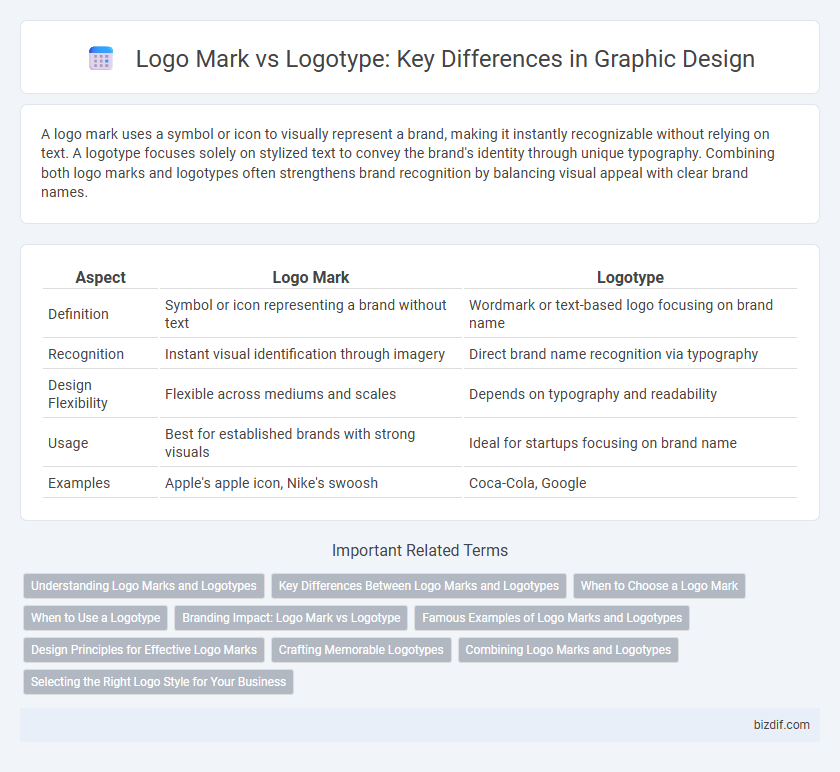A logo mark uses a symbol or icon to visually represent a brand, making it instantly recognizable without relying on text. A logotype focuses solely on stylized text to convey the brand's identity through unique typography. Combining both logo marks and logotypes often strengthens brand recognition by balancing visual appeal with clear brand names.
Table of Comparison
| Aspect | Logo Mark | Logotype |
|---|---|---|
| Definition | Symbol or icon representing a brand without text | Wordmark or text-based logo focusing on brand name |
| Recognition | Instant visual identification through imagery | Direct brand name recognition via typography |
| Design Flexibility | Flexible across mediums and scales | Depends on typography and readability |
| Usage | Best for established brands with strong visuals | Ideal for startups focusing on brand name |
| Examples | Apple's apple icon, Nike's swoosh | Coca-Cola, Google |
Understanding Logo Marks and Logotypes
Logo marks are graphic symbols or icons representing a brand without using words, emphasizing visual identity through shapes and imagery. Logotypes consist of stylized text or custom typography that spell out the brand name, focusing on unique font design to convey personality. Understanding the distinction helps in creating effective branding strategies that balance visual recognition with clear communication.
Key Differences Between Logo Marks and Logotypes
Logo marks use symbols or icons to represent a brand visually, offering immediate recognition through imagery, while logotypes rely solely on stylized text featuring the company name or initials to convey identity. The key difference lies in logo marks focusing on graphical elements independent of text, whereas logotypes emphasize typography as the primary design component. Understanding these distinctions is crucial for selecting a branding strategy that aligns with a company's personality and marketing goals.
When to Choose a Logo Mark
Choose a logo mark when you want a simple, memorable symbol that represents your brand visually without relying on text. Logo marks work best for companies aiming for strong brand recognition through iconic imagery, especially in industries like technology, fashion, and sports. They offer versatility across different media and sizes, making them ideal for apps, social media avatars, and merchandise.
When to Use a Logotype
A logotype is ideal when brand recognition relies heavily on the company's name, ensuring visibility and memorability in crowded markets. It works best for businesses with unique or distinctive names that need clear, readable typography to establish identity. Brands aiming for immediate clarity in communication often choose logotypes over logo marks to convey professionalism and trust.
Branding Impact: Logo Mark vs Logotype
Logo marks create a strong visual symbol that communicates brand identity quickly and memorably, enhancing recognition across diverse media. Logotypes emphasize the unique styling of a brand's name, fostering word recognition and reinforcing brand personality through typography. Effective branding often combines both elements to maximize impact, leveraging the visual power of logo marks and the narrative strength of logotypes.
Famous Examples of Logo Marks and Logotypes
Logo marks, such as the Apple logo and Nike's swoosh, rely on iconic symbols that convey brand identity without text, enabling instant global recognition. Logotypes, like Coca-Cola's cursive script and Google's colorful wordmark, emphasize distinctive typography to communicate brand personality and heritage. Both approaches leverage unique design elements that enhance memorability and strengthen brand presence across digital and print media.
Design Principles for Effective Logo Marks
Logo marks rely on simplicity, scalability, and memorability to create a strong visual identity that communicates a brand's essence without relying on text. Effective logo marks balance shape, color, and negative space to ensure versatility across different media and sizes, enhancing brand recognition and recall. Adhering to principles such as contrast, symmetry, and uniqueness ensures the logo mark resonates emotionally and stands out in competitive markets.
Crafting Memorable Logotypes
Crafting memorable logotypes involves a strategic focus on typography, ensuring each letterform reflects the brand's personality and values with clarity and uniqueness. Unlike logo marks that rely on symbols or icons, logotypes leverage custom font design and precise spacing to create a distinctive visual identity that enhances brand recognition. Effective logotype design balances readability with creativity, making the brand name itself a powerful marketing tool across various media.
Combining Logo Marks and Logotypes
Combining logo marks and logotypes creates a powerful brand identity by merging symbolic imagery with distinctive typography, enhancing brand recognition and versatility across media. This hybrid approach allows designers to leverage the visual appeal of a logo mark while communicating the brand name clearly through the logotype, optimizing both memorability and readability. Strategic integration of these elements ensures cohesive design that adapts seamlessly to various applications, from digital platforms to print materials.
Selecting the Right Logo Style for Your Business
Selecting the right logo style for your business involves understanding the distinction between a logo mark and a logotype. A logo mark uses a symbol or icon to visually represent the brand, ideal for businesses seeking simplicity and instant recognition. In contrast, a logotype relies on custom typography or stylized text to convey the brand name, enhancing brand identity through unique lettering and readability.
logo mark vs logotype Infographic

 bizdif.com
bizdif.com